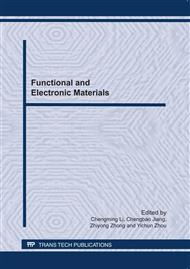p.183
p.189
p.194
p.199
p.204
p.209
p.215
p.222
p.228
The Effect of Sb Content on Spark Plasma Sintered High-Density Antimony-Doped Tin Oxide Ceramics
Abstract:
Spark plasma sintering (SPS) is a newly developed technique that enables poorly sinterable tin oxide powder to be fully densified. Sintering without sintering aids is of great importance when SnO2 ceramics are used as electrodes in the glass melting industry and aluminum electrometallurgy. Dense and good-conductive Antimony-doped SnO2 ceramics can be achieved by SPS at a lower sintering temperature and in a shorter time. When the Sb2O3 concentration is 1.0 mol%, the densities of the samples reach their maximum value, which is 98.2% of the theoretical value. When the content of Sb2O3 was 2.44mol%, SnO2 ceramics with densities 97.6% can be obtained at 800°C-1000°C, and the resistivity was about 5.19×10-2Ω.cm at the sintering temperature of 1000°C. Defined amount of Sb3+ used in our research are beneficial to low the sintering temperature and promote the densification of SnO2 ceramics
Info:
Periodical:
Pages:
204-208
Citation:
Online since:
June 2011
Price:
Сopyright:
© 2011 Trans Tech Publications Ltd. All Rights Reserved
Share:
Citation:


